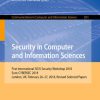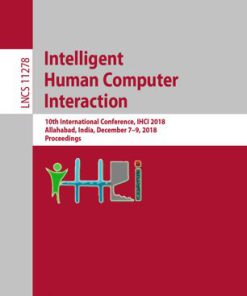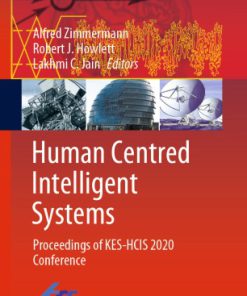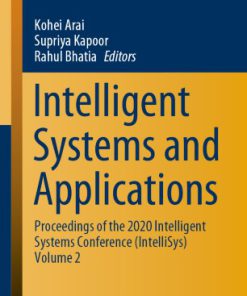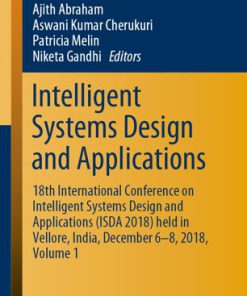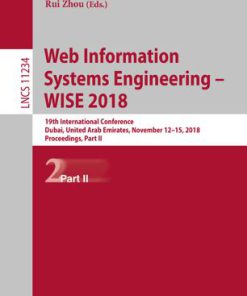Intelligent Human Systems Integration Proceedings of the 1st International Conference on Intelligent Human Systems Integration IHSI 2018 Integrating People and Intelligent Systems January 7 9 2018 Dubai United Arab Emirates 1st Edition by Waldemar Karwowski, Tareq Ahram ISBN 3319738879 978-3319738871
$50.00 Original price was: $50.00.$25.00Current price is: $25.00.
Intelligent Human Systems Integration Proceedings of the 1st International Conference on Intelligent Human Systems Integration IHSI 2018 Integrating People and Intelligent Systems January 7 9 2018 Dubai United Arab Emirates 1st Edition by Waldemar Karwowski, Tareq Ahram – Ebook PDF Instant Download/Delivery: 3319738879, 978-3319738871
Full download Intelligent Human Systems Integration Proceedings of the 1st International Conference on Intelligent Human Systems Integration IHSI 2018 Integrating People and Intelligent Systems January 7 9 2018 Dubai United Arab Emirates 1st Edition after payment
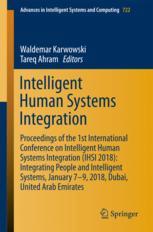
Product details:
ISBN 10: 3319738879
ISBN 13: 978-3319738871
Author: Waldemar Karwowski, Tareq Ahram
This book reports on research on innovative human systems integration and human-machine interaction, with an emphasis on artificial intelligence and automation, as well as computational modeling and simulation. It covers a wide range of applications in the area of design, construction and operation of products, systems and services, including lifecycle development and human-technology interaction. The book describes advanced methodologies and tools for evaluating and improving interface usability, new models, as well as case studies and best practices in virtual, augmented and mixed reality systems, with a special focus on dynamic environments. It also discusses different factors concerning the human, hardware, and artificial intelligence software.
Based on the proceedings of the 1st International Conference on Intelligent Human Systems Integration (IHSI 2018), held on January 7-9, 2018, in Dubai, United Arab Emirates, the book also examines the forces that are currently shaping the nature of computing and cognitive systems, such as the need for decreasing hardware costs; the importance of infusing intelligence and automation, and the related trend toward hardware miniaturization and power reduction; the necessity for a better assimilation of computation in the environment; and the social concerns regarding access to computers and systems for people with special needs. It offers a timely survey and a practice-oriented reference guide to policy- and decision-makers, human factors engineers, systems developers and users alike.
Table of contents:
1. A Design and Description Method for Human-Autonomy Teaming Systems
2. Current Insights in Human Factors of Automated Driving and Future Outlook Towards Tele-Operated Remote Driving Services
3. External HMIs and Their Effect on the Interaction Between Pedestrians and Automated Vehicles
4. Attuning the ‘Pedestrian-Vehicle’ and ‘Driver-Vehicle’ – Why Attributing a Mind to a Vehicle Matters
5. Designing a Proactive Risk Mitigation Environment for Integrated Autonomous Vehicle and Human Infrastructure
6. The 4D LINT Model of Function Allocation: Spatial-Temporal Arrangement and Levels of Automation
7. Study on Estimation of Driver’s State During Automatic Driving Using Seat Pressure
8. Automated Text Detection and Character Recognition in Natural Scenes Based on Local Image Features and Contour Processing Techniques
9. Continuous Model Based System Engineering (MBSE) Improvement via Human System Integration and Customer Change
10. Injecting Digitized Knowledge into the Technical Support Dialog
11. Artificial Intelligence and Interaction Design for a Positive Emotional User Experience
12. The Cognitive Airport Signage System Design: Comparative Case Study Between American Airport and Chinese Airport
13. Legal Risks and the Countermeasures of Developing Intelligent Investment Advisor in China
14. Reactive Operation: A Framework for Event Driven Low Voltage Grid Operation
15. Task Analysis of Diagnostic Ultrasound System Use: Comparison Between Sonographers’ and Physicians’ Use in Different Clinical Applications
16. Evaluation of the Quality of Internet Breast Cancer Information: Fuzzy VIKOR Approach
17. Research on an Improved Fall Detection Algorithm for Elder People
18. Estimating Driver Workload with Systematically Varying Traffic Complexity Using Machine Learning: Experimental Design
19. User Context Query Service Supporting Home Person-Centered Care for Elderly People
20. Significance of Social Factors for Effective Implementation of Smart Energy Management Systems in End-User Households
21. “Intelligent Bathroom” – Intelligent Decision for Health
22. Influence of Human Based Factors on Small Neighbourhood vs. Household Energy Load Prediction Modelling
23. A Prototype of a Small Tracked Robot for Gas Pipeline Inspection and Maintenance
24. Human Activity Detection Patterns: A Pilot Study for Unobtrusive Discovery of Daily Working Routine
25. Eye Movements and Lie Detection
26. What Are the Benefits of Newly Developed Medical Devices When the User Does not Use Them? – An Investigation of Hearing Aid Use
27. Development of an Active Upper Limb Orthosis Controlled by EMG with Upper Arm Rotation
28. Design and Experimental Validation of Transparent Behavior for a Workload-Adaptive Cognitive Agent
29. Intelligent Visual Analytics – a Human-Adaptive Approach for Complex and Analytical Tasks
30. CPR: Bright Side of Machine-Human Relationship
31. Surface Recalibration as a New Method Improving Gaze-Based Human-Computer Interaction
32. A Bionic Sphincter for Stress Urinary Incontinence: Design and Preliminary Experiments
33. Experimental Validation of Pilot Situation Awareness Enhancement Through Transparency Design of a Scalable Mixed-Initiative Mission Planner
34. Integrating 3D Facial Model with Person-Centered Care Support System for People with Dementia
35. Integration of Cognitive Cybernetics into Intelligent Human Systems
36. Gaze-Aware Cognitive Assistant for Multiscreen Surveillance
37. Computerized Brain Interfaces for Adaptive Learning and Assessment
38. Recognition of Affective States via Electroencephalogram Analysis and Classification
39. Non-obtrusive Sleep Detection for Character Computing Profiling
40. Biological and Social Factors that Exert an Impact on Decision Making During Working-Out of the Convergent Technologies
41. Humans and Color Cognition – Using the Brain to Study Human Behavior
42. Assessing the Effect of Care Treatment Using Face Emotional Analysis and Cognitive Computing
43. Identify Subconscious Visual Response from Brain Signals
44. EEG Analysis from Motor Imagery to Control a Forestry Crane
45. Exploring the Usage of EEG and Pupil Diameter to Detect Elicited Valence
46. Integrating Classes from Different Schools Using Intelligent Teacher Support Systems
47. AI Infused Fragrance Systems for Creating Memorable Customer Experience and Venue Brand Engagement
48. Will Sketching Survive with the Use of Artificial Intelligence Tools?
49. Research on the Construction of the Hierarchical Classification Model of the Urban Intelligent Lighting Appliance (UILA) Based on User Needs
50. Influence of Personal Characteristics and Device Properties on Wearable’s Rank Order
51. Comparative Analysis of the Quantitative Parameters of the Different Shapes of the Heart in Human Fetuses
52. A Practice of Flight Deck Evaluation in Civil Aircraft
53. Operator Response to Failure of a Computerized Procedure System
54. Human-Human Interaction: A Neglected Field of Study?
55. Smart Palletisation: Cognitive Ergonomics in Augmented Reality Based Palletising
56. Augmenting the Evaluation and Mapping of Progress in Scientific Research – A Human-Machine Symbiosis Perspective
57. Development and Evaluation of a Virtual Reality Grocery Shopping Application Using a Multi-kinect Walking-in-Place Approach
58. Influence of VR-Based Slope Images on Walking Pattern
59. The Concept of Narrative as a Fundamental for Human Agent-Based Modeling
60. An Agent Based Model of Saudi Household Electricity Consumption
61. Digital Human Modelling Method for the Evaluation of the Ultrasound System and Transducer Design Adherence to the SDMS Industry Standards
62. UX Design in the Localization and Internationalization of NASA’s Eyes on the Earth
63. Digital Media Art Utilizing Traditional Animation Digital Video Expression Using Projection Mapping and Multi Screen Technique
64. Guidance of Enterprise Team Division Based on Security Awareness and Interaction
65. Applying Process Mining Techniques to Learning Management Systems for Educational Process Model Discovery and Analysis
66. Explorations into Deep Learning Mobile Applications
67. Theoretical Propositions and Practical Implementation of the Formalization of Structured Knowledge of the Subject Area for Exploratory Research
68. Bayesian Network Construction and Simplified Inference Method Based on Causal Chains
69. Image Super Resolution Using Wavelet Transformation and Swarm Optimization Algorithm
70. Human Posture Tracking System for Industrial Process Design and Assessment
71. Instrumentation of an External Fixator for Force and Bone Healing Process Monitoring
72. Study of Visual Symbols Used in Food Packaging Identification for the Elderly Affected with Chronic Diseases
73. Research of a Falling Detection System for the Elderly Based on Three-Dimensional Acceleration
74. A Qualitative Model to Estimate Users’ Fear of Environmental Conditions for Evacuation Route Guidance
75. The Effects of Enterprise Staff Safety Consciousness Based on Cellular Automata Model
76. Machine-Man-Task System Approach and NR-17 Regulatory Standard
77. User Centered Ecological Interface Design (UCEID): A Novel Method Applied to the Problem of Safe and User-Friendly Interaction Between Drivers and Autonomous Vehicles
78. Statistics-IDE: Supporting the Design of Empirical Experiments for Non-experts During Early Stages of Research Projects
79. Measuring User Experience of Seniors in Battery Swapping Interactions
80. Web Page Graphic Design Usability Testing Enhanced with Eye-Tracking
81. Preliminary Research on Competency Model for High Plateau Airline Pilots
82. User Interface Design in Remote Aerodrome Flight Information Service
83. The Robot Brain Server: Design of a Human-Artificial Systems Partnership
84. Act like a Human: Teach an Autonomous Vehicle to Deal with Traffic Encounters
85. Design Approach for Sanpoyoshi Principle and Case Study
86. Identifying Significance of Human Cognition in Future Maintenance Operations
87. Collaborative Human-Machine Interaction in Mobile Phone Support Centers: A Case Study
88. Crew Resource Management Doctrine Applicability to Human-Machine Interaction in Commercial Aircraft
89. The Role of Monitoring and Evaluation in Construction Project Management
90. Transformations in Mass Society and Emergent Properties of Human Behavior in Contemporary Media Space
91. Modelling the Perceived Pragmatic and Hedonic Quality of Intelligent Personal Assistants
92. The Brave New E-world of the Human-Centered Media Ecosystem
93. Identification of Visually Impaired Person with Deep Learning
94. The Role of Mental Model in Graphical Password Selection and Design
95. Tablets and Smart Glasses in Modern Production Environments – A Lab Study on Distracted Walking
96. A Perception Study of a New Set of Usability Heuristics for Transactional Web Sites
97. On User eXperience Evaluation: Combining User Tests and Psychometrics
98. Research on Parent-Child Interaction System of Intelligent Children’s Furniture Based on Application Behavior Analysis
99. Adaptive Edge Analytics – A Framework to Improve Performance and Prognostics Capabilities for Dairy IoT Sensor
100. Evaluation of Legibility and Visual Fatigue Caused by Luminescent Text Displays
101. Multimodal Interactive Payment Based on Biometrics
102. Re-modeling the ‘Phonebook’ in a Smart Phone: Personalization Based on Intimacy and Immediacy
103. Smart Shopping Experience. New Materials and Technologies for Social Inclusion Through Daily Activities
104. Next Smart Design: Inclusion, Emotions, Interaction in the Concept of Baby Soothing, Caring and Monitoring Smart Solutions
105. Applied Semiotics in the Context of Open Government Data (OGD) Portals in the Arab Gulf
106. Cyclotourism and Social Inclusion: From Service to Product for a Smart Extra-Urban Bike Sharing
107. Service System-Based Urban Mobility System Design for Chinese Metropolis
108. Smart Cities-Smart Societies
109. City of Future
110. Between a Smart City and Smart Society
111. Hemp for a Healthy and Sustainable Building in Abruzzo
112. The Creative Space of University as a Cognitive-Generative System
113. The Emotional Side of Smartness: Intelligent Materials and Everyday Aesthetics
114. Mapping ICS Materials: Interactive, Connected, and Smart Materials
115. Bio-smart Materials: The Binomial of the Future
116. Exploring Scenarios for ICS Materials in the Yacht Design Framework
117. Advanced Materials Empowering Inclusive Engineering Design Processes
118. Interactive, Connected, Smart materials: ICS materiality
119. Study of the Ergonomics Applied to the Reuse and Recycling of Materials
120. Erratum to: Modelling the Perceived Pragmatic and Hedonic Quality of Intelligent Personal Assistants
People also search for:
intelligent systems examples
human systems integration salary
human system integration examples
human-intelligent systems integration
human-systems integration
Tags: Waldemar Karwowski, Tareq Ahram, Intelligent Human, Systems Integration, Proceedings, International Conference
You may also like…
Engineering - Computer Technology
Computers - Computer Science


